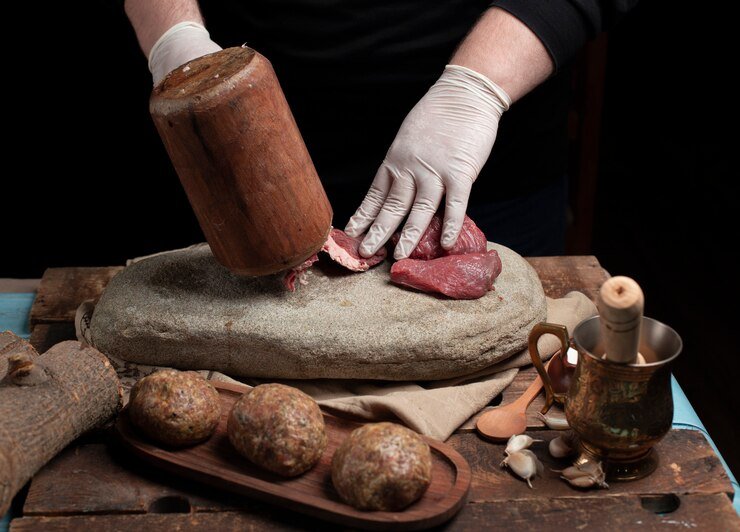The Sound of Stones and the Smell of Bread
Imagine the steady rhythm of stone against stone. A woman kneels by a flat slab, pressing grain with a rounded stone. Slowly, wheat turns into powder. The smell of flour rises, and before long, dough is shaped into bread for her family. Thousands of years ago, this was the soundtrack of daily life.
While today we toss flour into shopping carts without a second thought, the stone grinding ancient method was once at the heart of survival. For ancient cultures, turning grain into flour wasn’t just cooking it was life itself. And surprisingly, some of these traditions still survive, offering lessons in patience, taste, and nutrition.
Why Stone Grinding Matters
When you step back, the history of food is tied directly to grinding stones. Agriculture may have allowed people to settle, but it was grinding that made grains edible, nourishing, and versatile. Without it, wheat, barley, maize, and millet would have been nearly impossible to eat in bulk.
Stone grinding mattered because it:
-
Allowed cultures to turn wild grains into bread, porridge, and later pasta.
-
Preserved nutrients, since the slow grinding process didn’t heat or strip the grains like modern milling.
-
Created communal traditions grinding was often social, passed from generation to generation.
It wasn’t just a kitchen task. It was cultural, even spiritual, shaping both diets and societies.
The First Stone Grinders in History
Archaeologists have found grinding stones dating back over 30,000 years, far earlier than most people imagine. These tools were simple but effective, usually a flat stone (the quern) paired with a hand-held grinder (the handstone).
-
Prehistoric Europe: Women used saddle querns to grind wild seeds and later domesticated wheat.
-
Ancient Egypt: Farmers harvested barley and wheat, then ground them for bread—the “staff of life” in their diet.
-
Mesopotamia: Clay tablets even depict bread-making, where grinding stones were the first step.
-
Mesoamerica: The metate (a flat stone with a hand roller) was essential for turning maize into flour for tortillas and tamales.
Surprisingly, these stone grinders looked different across regions, but all served the same purpose: unlocking the calories inside grains that powered civilizations.
The Daily Life of Grinding
To understand the ancient stone grinding method, picture this:
A family wakes before sunrise. Grain harvested from the fields is poured onto a stone slab. For hours, women (and sometimes children) push the handstone back and forth. Their arms ache, but without this work, there’s no bread, no porridge, no food at all.
Grinding wasn’t glamorous; it was labor-intensive. In fact, historians say women in ancient societies spent four to six hours a day grinding grain. It was physical, repetitive, and exhausting, but it kept entire communities alive.
I once tried using a traditional stone grinder in an Indian village. After only fifteen minutes, my shoulders burned. But when I tasted the chapati made from that fresh flour, it was unlike anything I’d ever bought from a store—nutty, sweet, alive. That’s the difference.
Cultural Examples of Stone Grinding
India: The Sil-Batta
In India, families still use the sil-batta, a flat grinding stone, for spices and grains. Even with electric mixers, many households swear the taste of stone-ground masala is unmatched.
Mexico: The Metate
The Mexican metate has been in use for over 6,000 years. Women kneel to grind maize for tortillas, creating food that has fed generations. Even today, rural households still prefer the metate over machines.
Africa: Grinding Millet and Sorghum
In parts of Africa, women use large stone mortars to grind millet, creating porridge and flatbreads. The act is often communal, with rhythmic pounding forming part of social life.
Europe: The Rotary Quern
The Celtic people developed the rotary quern around 400 BCE. Instead of back-and-forth grinding, the top stone rotated against the bottom, making the process faster and less tiring. This small innovation spread across the continent.
Each of these examples shows how stone grinding wasn’t just about food—it reflected local traditions, climates, and community life.
Comparing Stone Grinding to Modern Milling
Today, most flour is produced in industrial roller mills. It’s efficient but not without downsides. To see the difference, let’s compare:
| Feature / Benefit | Stone Grinding: Ancient Method | Modern Roller Milling |
|---|---|---|
| Flavor | Nutty, rich, fuller taste | Neutral, often bland |
| Nutrient Preservation | Keeps bran, germ, and oils | Often strips away fiber & nutrients |
| Heat | Low, gentle grinding | High-friction heat alters the grain |
| Texture | Coarse, varied | Smooth, uniform |
| Shelf Life | Short (oils can spoil quickly) | Long (processed & refined) |
| Cultural Value | Deeply traditional | Purely industrial |
Here’s what this really means: modern flour lasts longer and looks prettier, but stone-ground flour carries taste, health, and history that machines can’t replace.
Expert Insights: Why Stone Still Matters
The Smithsonian Institution has published research noting how grinding stones are among the earliest human inventions. They weren’t just tools; they symbolized humanity’s shift from foraging to farming.
National Geographic highlighted the Mesoamerican metate as “an object that links modern cooks to ancient civilizations through the taste of maize.”
Even food scientists point out that whole-grain stone-ground flour has higher nutritional value. According to the U.S. Department of Agriculture (USDA), stone-ground flours retain more fiber, vitamins, and minerals compared to refined white flour.
So it’s not just romantic nostalgia, it’s scientific truth.
The Hidden Health Benefits
When you use the stone grinding ancient method, you’re not just following tradition—you’re eating healthier:
-
Stone-ground flour keeps the bran and germ, full of fiber and B vitamins.
-
The slower process preserves natural oils, which means more flavor and nutrition.
-
Some cultures even believe stone-ground foods are easier to digest because they’re less processed.
I’ve seen bakers swear that bread made from stone-ground flour rises differently, with a texture that feels alive compared to factory flour.
What We’ve Lost in Modern Kitchens
With industrialization, the sound of grinding stones faded. Convenience replaced patience. Bread became softer, whiter, cheaper, but also less nutritious.
What really stands out is this: in choosing speed, we lost connection. We lost the rhythm of stone against grain, the smell of freshly ground flour, and the knowledge that food comes from effort, not machines.
But here’s the good part: some bakers, farmers, and food enthusiasts are bringing it back. Small mills now sell stone-ground flour, reviving both health and heritage.
FAQs: Stone Grinding Ancient Method
Q1: Is stone-ground flour healthier than regular flour?
Yes. Stone-ground flour retains the whole grain, including bran and germ, making it richer in fiber and nutrients.
Q2: Why does stone-ground flour spoil faster?
Because it keeps the natural oils, which can go rancid. Modern flour removes these for longer shelf life, but at the cost of nutrition.
Q3: Can I try stone grinding at home?
Absolutely. Handheld stone grinders or small home mills are available. It takes time, but the flavor difference is worth it.
Q4: Which cultures still use stone grinding today?
India, Mexico, and parts of Africa still use stone grinders for daily cooking, proving the method’s lasting importance.
Final Thoughts: Stones That Built Civilizations
When you step back, the stone grinding ancient method wasn’t just about making flour; it was about making civilizations possible. Without these tools, bread, tortillas, and porridge would never have existed.
Every culture that picked up a grinding stone began shaping its identity through food. And while machines may have taken over, the story of stone grinders still lingers in kitchens, bakeries, and traditions worldwide.
So maybe the next time you bite into bread or a tortilla, pause and think of the stones that ground the grain centuries ago. The rhythm of those stones is still alive in every crumb we eat.



